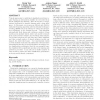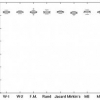94 search results - page 7 / 19 » The Random Subspace Method for Constructing Decision Forests |
CVPR
2007
IEEE
14 years 9 months ago
2007
IEEE
Linear and affine subspaces are commonly used to describe appearance of objects under different lighting, viewpoint, articulation, and identity. A natural problem arising from the...
KDD
2007
ACM
14 years 8 months ago
2007
ACM
Typical approaches to multi-label classification problem require learning an independent classifier for every label from all the examples and features. This can become a computati...
ICPR
2010
IEEE
14 years 1 months ago
2010
IEEE
—Randomized learning methods (i.e., Forests or Ferns) have shown excellent capabilities for various computer vision applications. However, it was shown that the tree structure in...
ICPR
2008
IEEE
14 years 9 months ago
2008
IEEE
Ensemble of Classifiers (EoC) has been shown effective in improving the performance of single classifiers by combining their outputs. By using diverse data subsets to train classi...
ACCV
2010
Springer
13 years 2 months ago
2010
Springer
Abstract. In set-based face recognition, each set of face images is often represented as a linear/nonlinear manifold and the Principal Angles (PA) or Kernel PAs are exploited to me...


